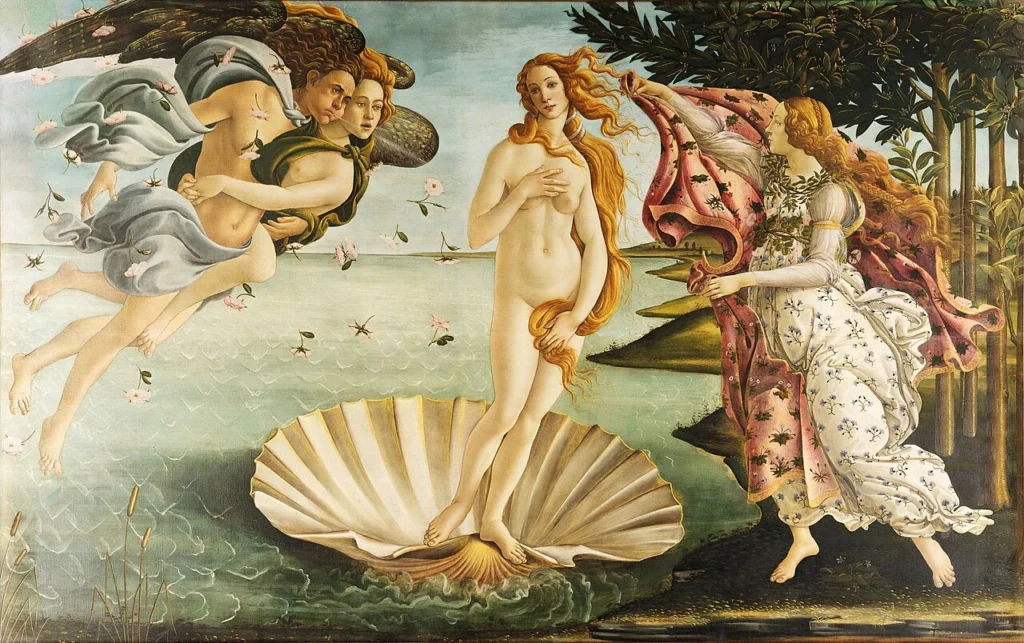Aphrodite, the goddess of beauty, possessed an exceptionally distinctive birth legend. Aphrodite’s father was Uranus, the personification of heaven, the sun, and the husband of Gaia. Unlike most gods, she emerged from a single body part. When Uranus was castrated, his severed genitals and white sea foam, gave rise to Aphrodite in a stunning female form.

Often portrayed as a gorgeous young woman adorned with long, flowing hair and a floral crown, Aphrodite, the Greek goddess of love and beauty, was equated with the Roman goddess Venus. She mainly represented love and fertility, with occasional associations with marriage.
Aphrodite’s origins vary in myth. Some tales claim she is the daughter of Zeus and Dione, while others narrate her emergence from sea foam after Cronus cast Uranus’ severed genitals into the sea. Born in Cyprus, she was nurtured by the Titans Oceanus and Tethys.
The Castration of Uranus
The tale of Aphrodite’s birth begins with the castration of Uranus. In a simpler version of the story by Hesiod, Gaia, the Earth, gave birth to Uranus, the Sky. They had eighteen children together, including twelve Titans, three Cyclopes, and three Hundred-Handers. Uranus didn’t like these children, so he hid them deep within Gaia.
Gaia became angry and made a strong sickle. She asked her children to punish Uranus, but only her youngest son Cronus agreed. Together, he and Gaia devised a strategy to confront Uranus during a moment of his vulnerability. They anticipated the time would be perfect when the celestial deity would descend to mate with Gaia once more.
Gaia helped Cronus hide and gave him the sickle. When Uranus came to be with Gaia, Cronus used the sickle to cut off Uranus’ private parts and threw them into the sea. This act allowed the Titans to become powerful, and Cronus became the leader of everything.
The droplets of blood that descended from Uranus’s form to the earth marked the final offspring Gaia would conceive with him. From these drops, the Erinyes(Daughters of Hades in alternate myths), also known as the Furies, emerged to enact vengeance for crimes, while the ash-tree nymphs brought forth the initial generation of humankind.
Who Was Aphrodite’s Father? Unsually A Body Part of Uranus
While some deities were born from a single parent, Aphrodite’s origins are entwined with a remarkably singular event. The story recounts how, following the castration of Uranus, his severed genitals mingled with the foamy sea waves, giving birth to Aphrodite in an exquisite female form.
Curiously, the birth of Aphrodite diverges from the meticulously structured succession pattern often seen in Greek creation stories. This is attributed to Aphrodite’s incorporation into Greek mythology at a later stage, once the overarching narrative had already taken shape and become established. The tale of Aphrodite’s unique birth, woven into the fabric of Greek mythology, reflects both her exceptional nature and the intricate evolution of ancient narratives.
Is Zeus Aphrodite’s Father?
Despite Uranus being Aphrodite’s biological father, Zeus played a notably active fatherly role in her life. In the absence of a conventional father, the supreme deity orchestrated her marriage to Hephaestus, the god of fire, and claimed the customary bride price. This arrangement underscores Zeus’s active involvement in Aphrodite’s existence.
Aphrodite in Greek Myth
Aphrodite’s birth set her apart from other gods, and unique among her generation. As Uranus’ daughter, she was a half-sister to the Titans, yet her birth was distinct. Born without a mother, she emerged from sea foam without an associated nymph, solely from Uranus. While contemporaneous with the Titans, she entered mythology after their fall, aligned with the Olympians. Her peculiar timeline and circumstances marked her as an outlier among gods, the most distantly related Olympian.
Her late introduction led to her integration into an already-established mythology. To be counted among the twelve main Olympian deities, she couldn’t have been active during the Titans’ rule. This narrative either challenges the timeline or implies a prolonged gestation within the waves.
Eastern Roots of Aphrodite
Historians largely agree that Aphrodite was taken from the Phoenician religion. The Phoenician goddess Astarte, a local variant of the Near Easter Inanna/Ishtar, was introduced to Greece fairly late in the Bronze Age.
Early Greek images of Aphrodite are virtually indistinguishable from those of the Phoenicians and even in later periods her symbols were similar to those of Astarte. The character of Aphrodite was not a part of Greek mythology long enough to widely diverge from her Eastern roots, or for her to be more fully incorporated into the creation myth.
It’s noteworthy that Aphrodite’s presence in Greek mythology was relatively brief compared to other deities, impeding a significant departure from her Eastern origins. Her integration into the Greek creation myth was also limited due to this.
Summary
This post on Aphrodite’s father and her unusual Birth explores the distinctive birth legend of the Greek goddess of beauty. Emerging from Uranus’s severed genitals mixed with white sea foam, Aphrodite’s birth was unlike other gods, making her unique among her generation.
Portrayed as a stunning young woman, Aphrodite represented love and fertility, linked to the Roman goddess Venus. Her origins varied in myths, some claiming Zeus and Dione as her parents, while others narrated her emergence from sea foam after Cronus cast Uranus’s genitals into the sea.
The article delves into the castration of Uranus and its repercussions, including the rise of the Titans and the creation of the Erinyes and humankind. Additionally, it examines the influence of Phoenician religion on Aphrodite’s origins and her limited integration into the Greek creation myth.
